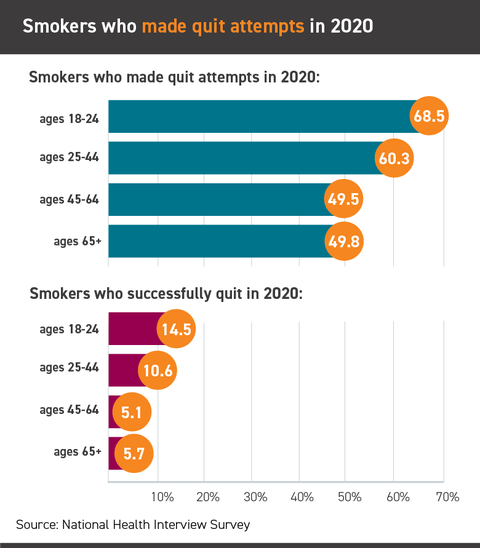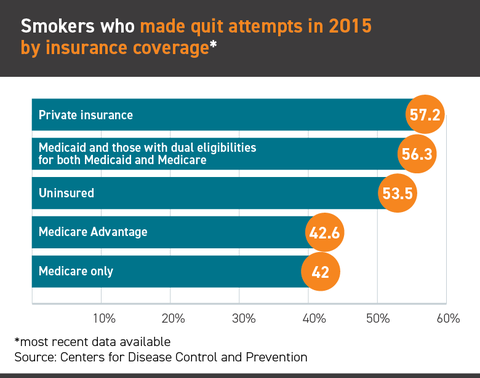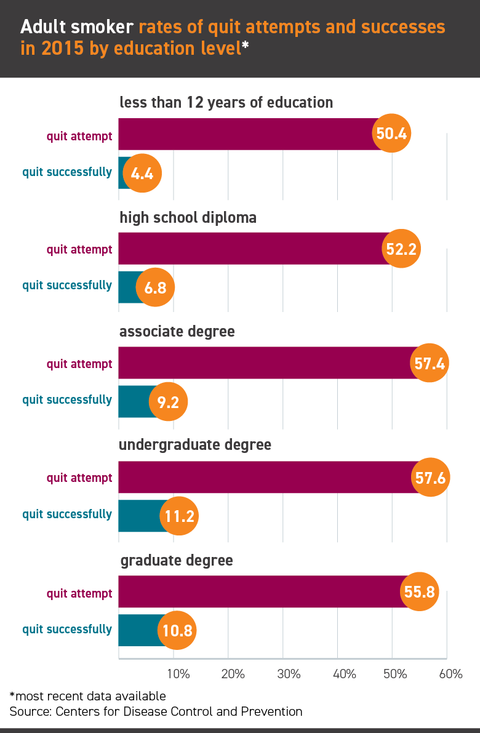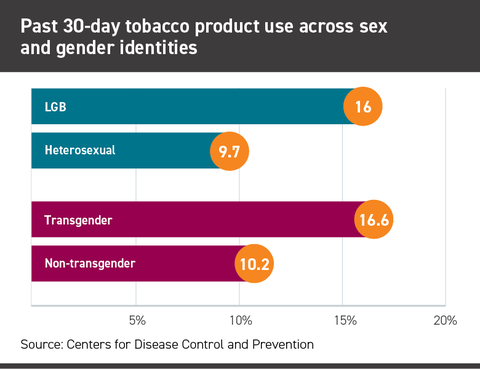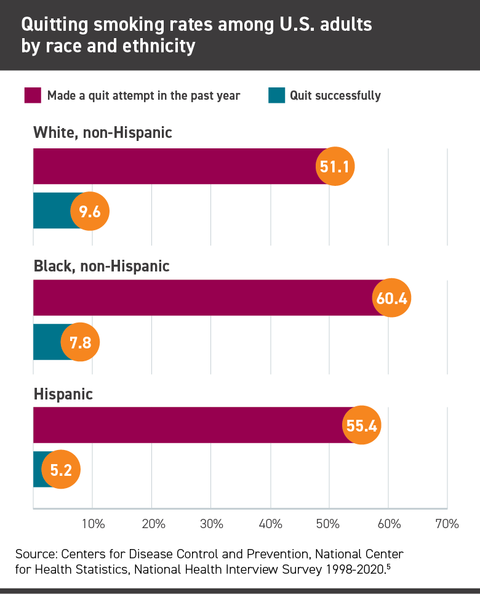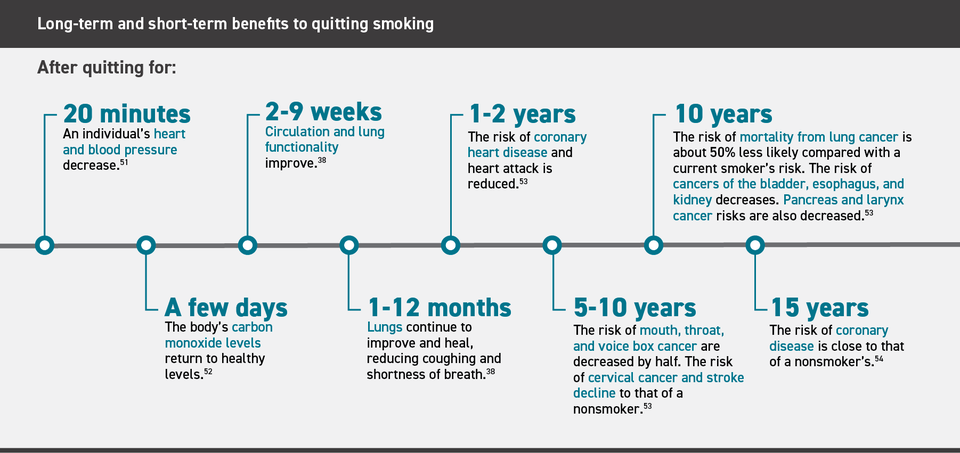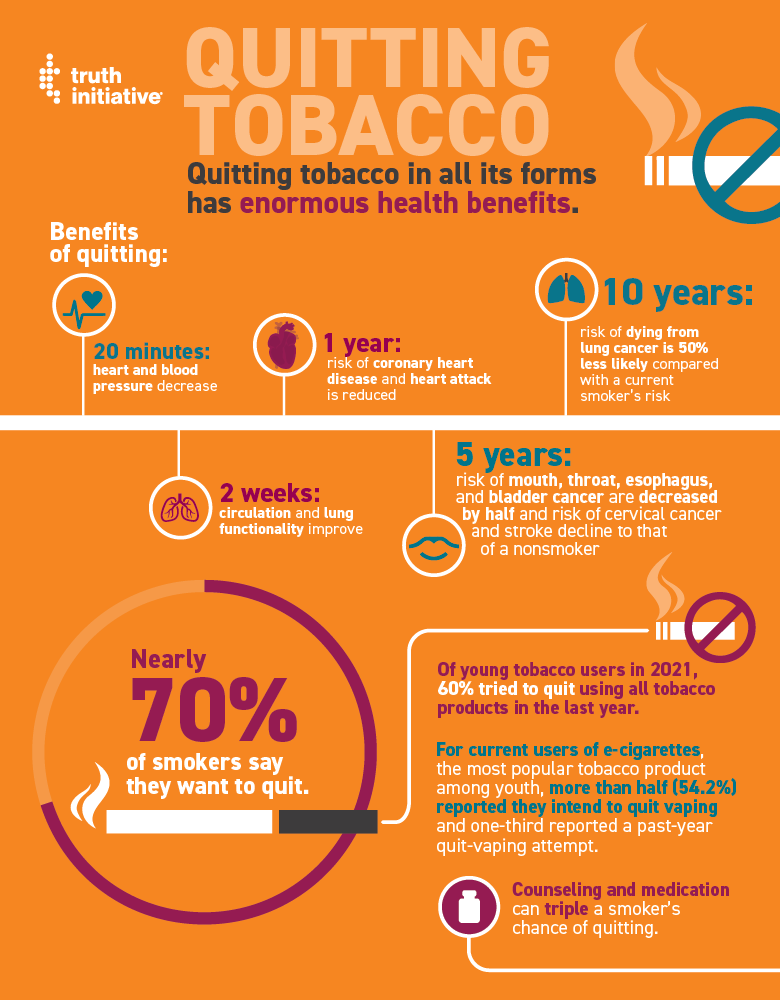Quitting Tobacco: Facts and Stats
Tobacco use is still the leading cause of preventable death and disease in the country and leads to 480,000 deaths in the U.S. each year from cigarette smoking alone. While cigarettes cause the most deaths from cancer, respiratory, and vascular disease, they are not the only tobacco product linked to adverse health outcomes. Using smokeless tobacco is a known cause of cancer, and the rise of new tobacco products like e-cigarettes, heated tobacco products, and products containing synthetic or non-tobacco-derived nicotine present emerging health risks. Nicotine is harmful to developing brains and its use during adolescence can disrupt the formation of brain circuits that control attention, learning, and susceptibility to addiction. Exposure to nicotine among youth is particularly dangerous since it affects key brain receptors, making young people more susceptible to nicotine addiction. Quitting tobacco in all its forms has enormous health benefits.

Most smokers — nearly 70% — say they want to quit, and many make quit attempts each year.
Most smokers – nearly 70% – say they want to quit, and many make quit attempts each year. In 2020, slightly more than half of current smokers (56%) made a quit attempt in the past year. Recent data show an increasing number of people quitting successfully. In 2020, 8.5% of adult current smokers successfully quit smoking in the past year, up from 7.5% in 2018. Among people who have ever smoked, the quit rate has also increased and is higher compared to current smokers, or those who have smoked more than 100 cigarettes in their lifetime and now smoke every day or some days. The successful quit rate among people who had ever smoked increased from 61.7% in 2018 to 66.5% in 2021.
Interest in quitting is also high among young tobacco users specifically. In 2021, around two-thirds of young tobacco users reported wanting to quit tobacco use altogether and made at least one quit attempt within the past year. For current users of e-cigarettes, the most popular tobacco product among youth, more than half (54.2%) reported they intend to quit vaping and one-third reported a past-year quit-vaping attempt.
Given overwhelming interest in quitting tobacco, online quitting resources are increasingly important to tobacco users. Twelve million U.S. smokers (35.9%) looked online for information on how to quit smoking in 2017, a number that more than doubled over the previous 12 years. Evidence shows that online quit-tobacco programs are increasingly popular – and successful. For example, following the EX Plan on BecomeAnEX.org, a free digital quit-smoking program developed by Truth Initiative® and the Mayo Clinic, quadruples a tobacco user's chance of quitting. Research also shows that young adults who used This is Quitting, the first-of-its-kind, text message-based quit vaping program from truth®, had nearly 40% higher odds of quitting compared to a control group.
QUIT RATES FOR ADULTS
Cigarettes
In 2021, approximately 11.5% (37.9 million) of American adults were current smokers, including 10.1% of women and 13.1% of men. Quit attempts among smokers (about 55%) and rates of successful quit attempts (8%-9%) are similar among men and women. For many smokers, it may take 30 or more quit attempts before successfully quitting smoking. Chances of success increase with each quit attempt.
Quit attempts and quit rates decrease with age, possibly because of increased difficulty changing behaviors that have been established over many years, according to data from 2021.
E-cigarettes
Adult e-cigarette use has remained relatively low since around 2012. The overall adult prevalence of e-cigarette use in 2021 was 4.5%, up from 3.7% in 2020. Although there aren’t much data on e-cigarette quitting rates, there is research on quit attempts for e-cigarette users:
- Among current e-cigarette users between ages 15-36 in 2021, 54.2% reported general intentions to quit, 15.3% reported intention to quit within 30 days, and 33.3% reported a past-year quit attempt.
- Adult e-cigarette users who were never smokers had the highest rates of past quit-vaping attempts (20.9%), compared to dual users (15.3%) and former cigarette smokers (7.9%).
QUIT RATES FOR YOUTH
Rate of teens quitting vaping
Approximately 3.08 million youth were current users of any tobacco product in 2022, according to the National Youth Tobacco Survey. In 2021, more than 60% of youth tobacco users reported wanting to quit or trying to quit in the past year.
Unsuccessful quit attempts among adolescents declined steadily between 1997 and 2019 from 9.82% to 1.27%, according to data from the Monitoring the Future study. In 2020, there was a significant increase (5.74%) in unsuccessful quit attempts among adolescents who used cigarettes or e-cigarettes, suggesting that e-cigarettes are substantially contributing to unsuccessful quit attempts among adolescents.
Cigarettes
- About 1 million high school and middle school students reported currently smoking any combustible tobacco product in 2022. In 2021, 65.3% of high school and middle school students reported wanting to quit all tobacco and 60.2% who were current tobacco users had tried to quit within the past year.
- More female (52.8%) than male (39.7%) students had attempted to quit smoking in 2018.
E-cigarettes
- More than half (54.2%) of current e-cigarette users between ages 15-36 reported they intend to quit vaping and one-third reported a past-year quit-vaping attempt, according to Truth Initiative research published in 2021.
- 4.12% of middle and high school students who had ever used e-cigarettes reported an unsuccessful quit-vaping attempt in 2020, nearly double the 2.23% who reported an unsuccessful quit-smoking attempt.
- Concern about health was the top reason for wanting to quit vaping in both 2019 and 2022, according to a 2023 study of young people enrolled in a text-based quit-vaping program by Truth Initiative. Cost as a reason for wanting to quit went down in 2022, while motivations around health – including mental health – increased, compared to 2019.
DISPARITIES IN QUITTING
Quitting disparities exist among certain populations, including in communities with lower income and education, racial and ethnic minority groups, and the LGBT community.
- Fewer lower-income smokers quit successfully (5.6%) than those living at or above the poverty line (7.9%), despite similar rates of quit attempts. Low-income individuals tend to have less awareness of and access to quit-smoking treatments and use them at low rates.
- In 2015, adult smokers with a private health plan had higher rates of successfully quitting (9.4%), compared with those with any other type of insurance coverage. Adults with private insurance also had the highest rate of quit attempts in the past year (57.2%), compared with those enrolled in federal insurance programs or who are uninsured.
- A stronger set of tobacco control policies – including broader cessation treatment coverage, tax increases, comprehensive marketing restrictions, smoke-free laws, strong graphic health warnings, a higher intensity media campaign, and stronger youth access enforcement – would reduce the smoking prevalence among the bottom two-fifths of income earners by nearly a quarter in just a few years. By 2065, smoking prevalence among the lowest-income groups would drop by almost 45%, avoiding more than 1.5 million deaths.
- Rates of quit attempts and successfully quitting generally increase as education level rises, with 50% of adult smokers across all education levels attempting to quit, according to data from 2015.
Lesbian, gay, and bisexual (LGB) individuals have higher prevalence of tobacco use and lower quit attempt rates than the general population.
- In 2020, 18.9% of lesbian, gay and bisexual adults were current smokers, compared with 15% of heterosexual adults, according to data from the National Health Interview Survey.
- In 2022, youth identifying as LGB or transgender reported higher rates of past 30-day tobacco product use than their heterosexual or cis-gender peers.
- Between 2020 and 2021, e-cigarette use by young people identifying as LGB increased more than their heterosexual peers, widening the gap between vaping rates based on sexual orientation, according to Truth Initiative surveys.
- About two-thirds (66.7%) of gay, lesbian and bisexual adult smokers were interested in quitting smoking, and 48.4% attempted to quit in the past year, according to the 2015 National Health Interview Survey. Both rates were lower than those who identify as heterosexual (68.1% and 55.4%, respectively).
Rates of quitting attempts and successfully quitting vary by racial and ethnic background. Among White, Black, and Hispanic American adults in 2020, Black Americans had the most quit attempts while White Americans had the highest quit-smoking rates. Hispanic Americans had the lowest quitting rates. A 2015 study found that Asian-Americans had the highest quit rate and rate of success.
Additionally, evidence indicates that adult menthol smokers are less likely than non-menthol smokers to successfully quit smoking. The minty flavoring has cooling properties that make cigarettes easier to smoke and harder to quit. [See “Menthol: Facts, stats and regulations” for additional information]
- Certain groups smoke menthol cigarettes at higher rates, including young people, women, sexual minorities, those with mental illness, and racial and ethnic minorities, especially Black Americans.
- About 85% of all Black American smokers use menthol cigarettes.
- Research shows that if menthol cigarettes were banned nationally, almost 39% of all menthol smokers and 44.5% of Black American menthol smokers would try to quit.
Tobacco marketing undermines quitting
The tobacco industry has a history of marketing its products in ways that can widen the gaps in tobacco use and interfere with quit-smoking attempts, especially among vulnerable populations. For example, a study published in 2023 found that former smokers who received cigarette coupons – particularly within one year of quitting – were more likely to relapse, compared to those who did not receive coupons. Past Truth Initiative research has shown that nearly all mailed ads for tobacco products in a study sample included price discounts, and many used youthful models and themes appealing to young people and Black audiences. Findings from another study suggest that in-store advertising of tobacco products can interfere with successful quitting.
HEALTH / MENTAL HEALTH EFFECTS OF QUITTING TOBACCO
Benefits of quitting vaping
Quitting tobacco in all its forms has numerous health and mental health benefits. In addition to the well-established long- and short-term health benefits of quitting smoking, quitting is also linked with lower levels of anxiety, depression, and stress, as well as improved positive mood and quality of life compared with continuing to smoke, according to a 2014 meta-analysis of 26 studies about smoking and mental health published in the British Medical Journal.
Quitting cigarettes
- Several studies show that quitting smoking substantially reduces the risk of dying from a smoking-related disease and adds years of life, regardless of gender and age.
- Quitting smoking reduces the risk of chronic obstructive pulmonary disease, lung cancer, gastrointestinal cancer, and urinary cancers among several others. In a systematic review and meta-analysis, quitting smoking at or around the time of lung cancer diagnosis was significantly associated with survival among patients.
- Smoking increases a patient’s chance of complications with surgery. Patients who quit smoking just before surgery see better and faster healing. Even brief periods of abstinence from smoking may improve surgical outcomes.
- A smoker’s body has a harder time healing wounds. Smoking also weakens the immune system. Stopping smoking immediately improves the body’s ability to heal itself.
- In a study among patients who experienced a heart attack with a completely blocked coronary artery, those who continued to smoke a year after the event had worse cardiovascular outcomes and death compared with nonsmokers. Those who quit smoking appeared to have similar long-term health outcomes to nonsmokers.
Quitting vaping
While research on the benefits of quitting vaping is emerging, the negative health effects of vaping are clear. E-cigarettes contain nicotine, sometimes at levels near or exceeding those found in combustible cigarettes. Nicotine is harmful to developing brains: younger users are more likely to become addicted, have more difficulty quitting and may be at higher risk for addiction to other substances in the future. [See “E-cigarettes: Facts, stats and regulations” for more information.]
There are concerning connections between vaping and mental health.
- Current e-cigarette users have double the odds of having a diagnosis of depression compared to those who have never vaped, according to a 2019 JAMA study of nearly 30,000 current e-cigarette users.
- Frequent vaping is tied to even higher odds (2.4x) of having a diagnosis of depression compared to never users.
- There is emerging evidence of a link between quitting vaping and improvements in mental health symptoms.
- Truth Initiative survey data finds that 90% of those who quit said they felt less stressed, anxious, or depressed and 47% of respondents who quit vaping reported that when they quit vaping they felt more in control. Among those who haven’t quit, nearly 80% believe they’ll gain a better sense of self if they do.
Quitting and pregnancy
In 2020, about 5.5% of American births were to women who smoked during pregnancy. In a 2019 study, researchers found only 25% of women who smoked during pregnancy were able to quit successfully during their pregnancy, and half of women who smoked during pregnancy smoked over 10 cigarettes per day. Among postpartum women who received cessation treatment during pregnancy, 43% of return to smoking after approximately six months.
Smoking while pregnant can harm the child and mother. Quitting smoking has enormous health benefits, such as increasing babies’ oxygen intake and lung development, and decreasing risk for premature birth, low birth weight and possible miscarriage. Quitting while pregnant greatly lowers how smoking affects fetal growth, but quitting early on is capable of fully eradicating the negative effects.
QUIT METHODS
Ways to quit vaping or smoking
Most smokers who attempt to quit do so without counseling or Food and Drug Administration (FDA)-approved medications – commonly called the “cold turkey” method – and are not successful. Only 3 to 5% of people quit for longer than six months using the cold turkey approach, according to quit-smoking experts. Many supports exist that can help people quit, including medications and counseling, which together can more than triple a smoker’s chance of quitting.
- Based on extensive clinical trials, the FDA has approved the following medications for quitting tobacco: nicotine replacement therapy (NRT) gum, NRT inhaler, NRT lozenges, NRT nasal spray, NRT patch, varenicline and bupropion. These medications have been demonstrated to improve quit rates by 50 to 70%.
- Providing sufficient training in quit-smoking treatments to health care providers can more than double a smoker’s odds of successfully quitting.
- Social support, such as seeking help from family and friends or building relationships with other smokers through online social networks, is an important factor related to successful quitting.
- Quitting methods that combine counseling and medication are more effective than either alone. Quitting resources should provide multiple options for smokers to choose the method that works best for them.

Counseling and medication can more than triple a smoker’s chance of quitting.
DIGITAL QUIT TOOLS
Help to quit vaping online
In addition to counseling and FDA-approved medications to support quitting tobacco, quitting support programs delivered online or by text can provide those looking to quit using cigarettes, e-cigarettes, or other tobacco products a network of support they need to successfully quit.
Digital quit smoking programs
- Digital quit tools – specifically those delivered online or through text message – have the potential to reduce smoking rates because of their proven effectiveness, broad reach, scalability, and relatively low cost.
- Online quit smoking programs have demonstrated comparable effectiveness with evidence-based telephone and face-to-face counseling.
- Research on the EX digital quit smoking program found that smokers who participated in the online community – either actively exchanging messages with others, or even just passively reading comments – were significantly more likely to quit than those who did not use the community. Each month, thousands of EX Community members share information and offer each other support through the platform’s communication channels, including private messages, blogs, message boards, and group discussions.
Digital tools to quit vaping
- This is Quitting, Truth Initiative’s first-of-its-kind, free and anonymous text message quit vaping program for teens and young adults, has helped over 700,000 young people on their journey to quit using e-cigarettes as of January 2024.
- Research shows that This is Quitting works: The quit-vaping program increased quit rates among young adult e-cigarette users aged 18-24 by nearly 40% compared to a control group, according to a 2021 randomized clinical trial published in JAMA Internal Medicine. Results were consistent across all demographics, nicotine dependence, social influences to vape, mental health symptoms, and other substance use.
- The quit vaping program also ensures that young people don’t later use combustible tobacco products in place of e-cigarettes. More young e-cigarette users who used This is Quitting abstained from using e-cigarettes and combustible tobacco products (25.9%) compared to a control group that did not receive quitting support (18.5%), according to research published in Preventive Medicine.
Interested in quitting tobacco products?
Truth Initiative has helped thousands of people on their journeys to become tobacco-free.

A free digital quit-smoking program developed by Truth Initiative in collaboration with Mayo Clinic.
Learn More

A digital quit-smoking program, developed by Truth Initiative in collaboration with Mayo Clinic, that is designed for employers, health systems, and health plans to offer to their employees and members. In addition to the free BecomeAnEX.org platform, the EX Program gives participants features such as live chat coaching and quit medication delivered to their home, and provides clients with data on program performance, incentive reporting, and promotional resources.
Learn More

A free and anonymous text messaging program from Truth Initiative designed to help young people quit vaping. The first-of-its-kind quit program has helped over 700,000 youth and young adults on their path to quit vaping by incorporating messages from other young people like them who have attempted to, or successfully quit, e-cigarettes.
This is Quitting is tailored based on age (13-24 years old) and product usage to give teens and young adults appropriate recommendations about quitting. Teens and young adults can join for free by texting DITCHVAPE to 88709
Learn More
Can e-cigarettes help people quit smoking?
To date, no e-cigarette product has been approved by the FDA for smoking cessation. In contrast, nicotine replacement therapies (e.g., patch, gum, lozenge) and some prescription medications (i.e., varenicline, bupropion) have been evaluated by the FDA and found to be safe and effective at helping people quit smoking.
There is limited evidence that e-cigarettes may be effective aids to promote smoking cessation to date. Some studies have shown that e-cigarettes may help smokers quit using cigarettes, while others have found e-cigarettes to be ineffective. A 2022 meta-analysis of 61 studies reported “high certainty” that people using nicotine e-cigarettes had higher quit rates, compared to people randomized to using nicotine replacement therapy. Another 2021 meta-analysis found that randomized controlled trials offering free e-cigarettes to research participants increased likelihood of cessation. The same meta-analysis noted that e-cigarette use was not associated with increased smoking cessation among observational study designs. These conflicting findings may be explained by differences in participant selection and environmental context across studies.
Considering these factors, more evidence is needed to understand how e-cigarette use can aid smoking cessation. However, because the youth e-cigarette epidemic in the U.S. and the youth appeal of flavored e-cigarettes go hand in hand, Truth Initiative strongly supports removing all flavored e-cigarettes from the market, regardless of device type. At a minimum, an e-cigarette manufacturer must show that the flavor itself is safe, helps smokers switch completely from combustible cigarettes, and does not attract youth before a product is allowed to go to market. In addition to flavor restrictions, Truth Initiative supports strong regulations to keep all tobacco products, including e-cigarettes, away from youth. Smokers who use e-cigarettes to quit smoking should ultimately also quit vaping.

HEALTH CARE COVERAGE FOR QUITTING TOBACCO SUPPORT
The Affordable Care Act requires most health insurance plans, including Medicaid expansion, individual insurance plans, small groups plans, and employer-provided plans, to cover preventive services that the U.S. Preventive Services Task Force recommends. Health insurance plans are in compliance with this requirement if they cover the following without cost-sharing:
- Screening for tobacco use
- At least two quit attempts per year, including coverage for:
- Four quitting counseling sessions of at least 10 minutes each (including telephone counseling, group counseling, and individual counseling) without prior authorization
- All seven FDA-approved quitting medications (including both prescription and over-the-counter medications) for a 90-day treatment regimen when prescribed by a health care provider without prior authorization
- Traditional Medicaid covers quitting counseling and medications with no cost-sharing for pregnant women. For all other Medicaid enrollees, quitting medications are no longer excludable from coverage. Cost-sharing and coverage of counseling vary by state and plan.
- Medicare covers NRT nasal spray, NRT inhaler, bupropion and varenicline only. Part D plans can cover other quitting medications. Medicare also covers two counseling attempts each year with four sessions of counseling in each attempt. Cost-sharing depends on whether a Medicare enrollee has been diagnosed with an illness that is caused or complicated by smoking.
- TRICARE, the health care program for military services members and their families, covers quitting counseling from TRICARE-authorized providers in the U.S., TRICARE also covers all seven FDA-approved quitting medications (including both prescription and over-the-counter medications) when prescribed by a TRICARE-authorized provider.
ACTION NEEDED: QUITTING TOBACCO
Evidence-based quit treatments lower smoking rates and save lives and money. A large body of research on quit smoking treatments confirms that a combination of behavioral counseling, medication and social support is the most effective way to treat this deadly addiction. Research also demonstrates the effectiveness of a broad range of health care providers asking about tobacco use, referring tobacco users to treatment, and delivering direct quitting methods. We know that longer duration and comprehensive services and interventions are more successful in helping people quit. As a result, these services, which are relatively inexpensive, provide a strong return on investment.
- All health care providers should inquire about their patients’ tobacco use status and recommend quitting medications and counseling as a matter of course for all patients who visit them. Providers can use the five “a’s” (ask, advise, assess, assist, and arrange) to help current tobacco users create a plan to quit, prepare to quit, and stay tobacco-free.
- People who currently use tobacco products need to be aware of effective cessation services and interventions. Mass media campaigns like CDC's Tips from Former Smokers need to run for additional weeks, and ads that target specific, high-risk populations should be developed. These ads should correct the myths about medicinal nicotine to encourage greater uptake and adherence.
- Quitting treatments offered to tobacco users must be comprehensive. All health care plans should cover all seven FDA-approved medications as well as individual and group counseling delivered in person, online, or by phone with no cost-sharing for plan enrollees.
- Given that it takes most smokers multiple attempts to quit before successfully quitting for one year or longer, all health plans should refrain from placing limits on the number of quit attempts covered.
- The data already exist to support FDA quickly approving existing nicotine replacement therapies (NRT) for long-term use.
- FDA should encourage the development of additional safe and effective interventions – whether they are drug interventions or device interventions. Because smokers are turning to e-cigarettes for help quitting, the FDA must fully regulate e-cigarettes so that consumers know which products might help them completely switch from combustible products or quit altogether. The agency’s Center for Tobacco Products must complete, as soon as possible, a full review of all e-cigarette products, including youth-appealing flavored disposable e-cigarettes. At the same time, the agency’s Center for Drug Evaluation and Research must develop a properly incentivized pathway for e-cigarettes and other products to potentially be approved as quitting drugs. FDA should ensure that any such interventions are on a fast-track and given priority for review.
- Implementation of policies (i.e., restricting the sale of flavored tobacco products, smoke-free housing, smoke- and vape-free workplaces, and increasing excise taxes on tobacco products) should include making quitting tobacco treatments available for those affected by such policies.
- States should fully fund comprehensive tobacco control programs that produce meaningful outcomes, including funding quitting resources for people of all ages. In fiscal year 2024, the states will collect $25.9 billion from the tobacco settlement and taxes, but they will spend just 2.8% of it – $728.6 million – on tobacco prevention and cessation programs for people of all ages, less than a quarter of what the CDC recommends.
- State governments, employers and health insurers should expand access to digital quitting resources. Internet and text message interventions are recommended by the Surgeon General and are often the first place that tobacco users look for assistance in quitting.

